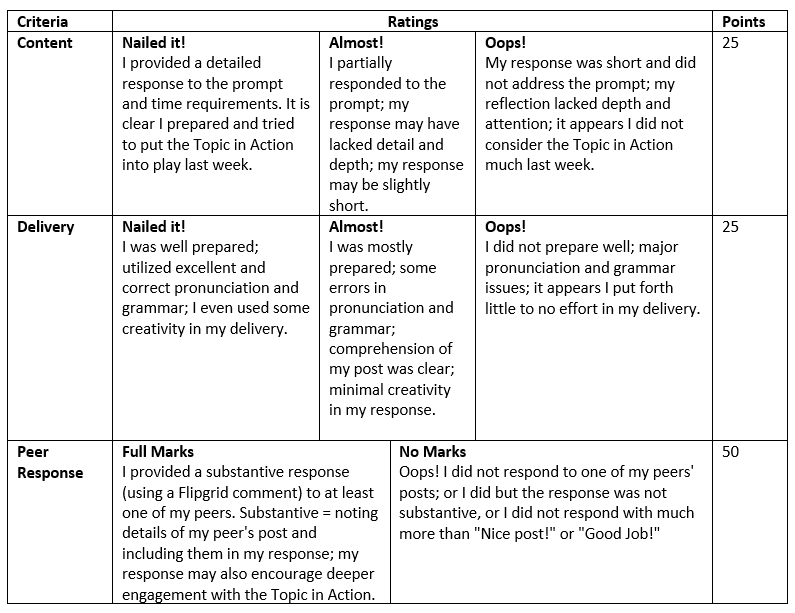Snapshot
This IDeaBook post is focused on the use of Flipgrid (2020) to increase student engagement in a fully, asynchronous online Freshman Seminar course.
Freshman Seminar, or US 1100, is not usually a class offered online, but this past Fall I had the opportunity to take on the challenge of delivering a fully asynchronous version with two sections of US 1100. Being that the course curriculum works best in small sections, with student-to-student engagement a cornerstone of the class format, I was a bit concerned about how I was going to achieve the same level of student connection with a class population that included students beginning their freshman year of college from home, students helping provide childcare for their siblings, students helping with their family’s business, and students in multiple time zones (including internationally).
One of the activities I really enjoy doing in the face-to-face course is something I call “Topic in Action.” With guidance, students take the weekly class topic and apply it throughout the week. To create a similar experience online, I used Flipgrid, a discussion platform using video. I also used Flipgrid to conduct first week introductions. I responded to every student’s introduction post. However, for the remaining Topic in Action activities, I created a summary of the student responses and peer responses into an end-of-module announcement.
Examples of Topic in Action assignments are:
Topic: Mindfulness
Topic in Action: Choose one of the mindfulness exercises presented and try it out throughout this week. You are welcome to try more than one. In fact, I encourage it. You never know which exercise might be the best fit for you. Whatever you choose, pay attention, and notice the experience. Then take notice of your emotional state and response to other events throughout the week.
Topic: Study Skills
Topic in Action: First, use the checklist to review your study area. Then, pick any one of the study skills strategies presented in this module and try it out this week. Feel free to apply more than one but choose at least one study skill from the list and implement it in your study routine.
Topic: Grit
Topic in Action: Now that you have done the Grit Scale, try putting one of the tips from the “How to Increase Grit” list into practice this week.
In the module that follows, students are presented with their Flipgrid activity. I provide written instructions alongside a video with the questions that students should address in their 2-minute video response:
The students respond individually to the post. They are then asked to respond to at least one peer. In this example, the initial response to the prompt sits at the top of the page. The student peer responses follow below it.
I have found the use of Flipgrid in my class to be something I look forward to every week. I have gotten to know my students with the use of these videos and students have gotten to know each other as well. One student reported making a friend that she connects with outside of class because of the platform. Another student reported being initially concerned with having to post weekly videos, but then quickly realized that the posts were less formal than traditional discussion forums, were easy to make, and even started to be fun. Many students have added personal elements in addition to the prompt requirements, like adding in music or relating a personal interest. One of my favorite outcomes from the videos is the encouragement students give to each other. One student expressed concern for another student when they heard the other student talk about their tendency to cram before exams. The responding peer said, “No, you can’t do that! I hope you are able to try healthier study habits.”
To set up the Flipgrid activities in Canvas, I use Assignments. I set the assignment to “No Submissions.” Because some students prefer to use their mobile device, I provide the “join code” so that students can access Flipgrid through the mobile app.
Although I find the benefits of Flipgrid far outweigh any challenges, I offer two considerations:
- Some students do not want to post videos of themselves. Some students overcame this by using an alternative visual (like art or a blacked-out screen so that the post is audio only). One student asked for an alternative written assignment.
- Grading is time consuming. I watch all student posts. It usually takes several hours each week to get through the original posts and the peer responses. As I watch the videos, I also take notes from the posts so that I can generate a roll up announcement summarizing the class responses. I use a simple grading rubric that makes posting grades quick and easy. My rubric is provided below.
 A ‘paper’ copy of the rubric is linked here.
A ‘paper’ copy of the rubric is linked here.
References:
Flipgrid [Computer Software]. (2020). Retrieved from https://info.flipgrid.com/

